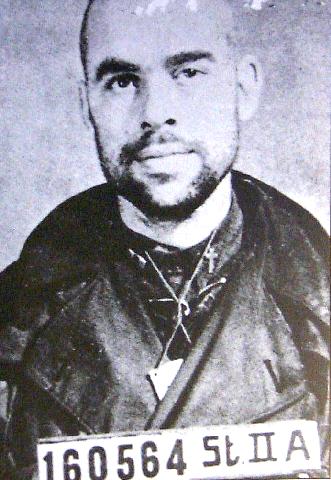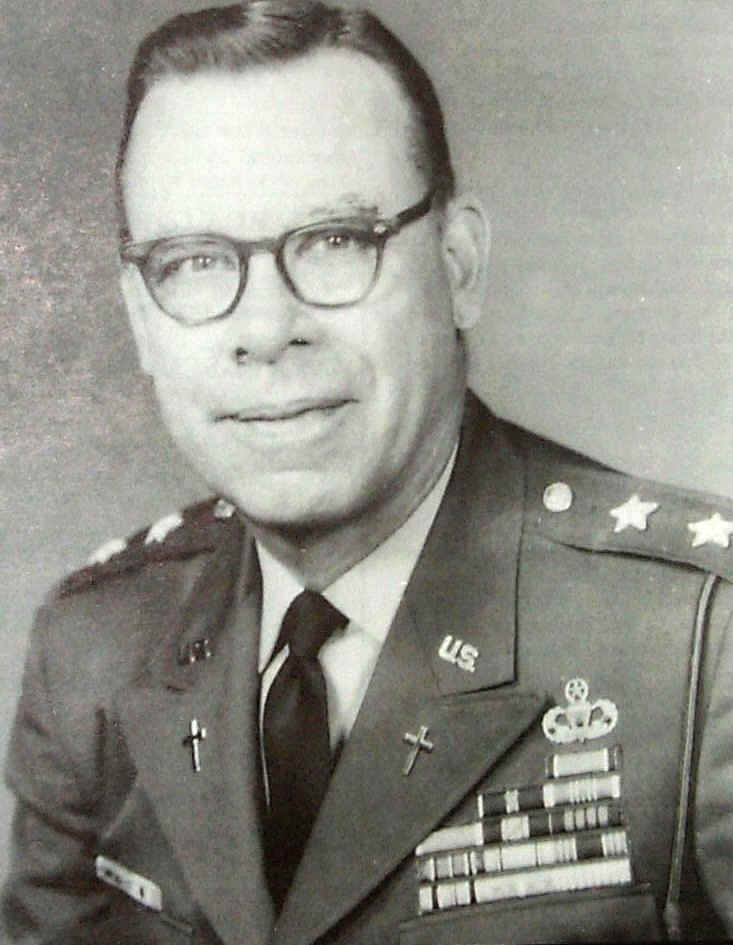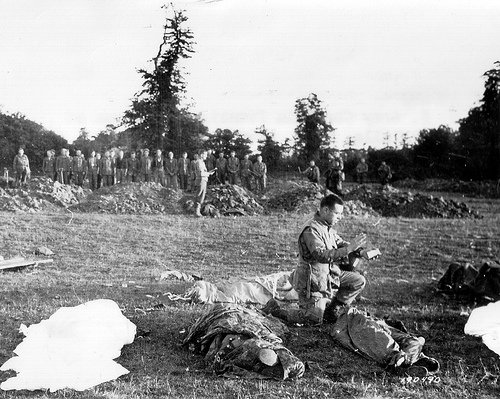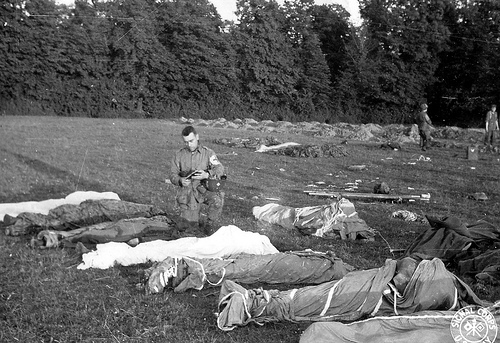FRANCIS l SAMPSON
 <=
Father Sampson prisoner of war at Stalag II A, 1945.
<=
Father Sampson prisoner of war at Stalag II A, 1945.
Father Sampson, Major General,
1967 =>
François L Sampson was born in Cherokee , Iowa February 29, 1912
.
He attended Notre Dame University where he graduated in 1937.
Then he entered the St Paul's Seminary in St. Paul, Minnesota.
He was ordained Roman Catholic for the Diocese of Des Moines, Iowa June 1, 1941
.
After being ordained a priest , Father Sampson briefly served as a priest in
the parish of Neola , Iowa and taught at Dowling High School in Des Moines .
He entered the army in early 1942 when he was appointed 1st Lieutenant .
His military career began at Camp Barkley , Texas.
In January 1943, he led the
Chaplain School, he followed a special training for chaplain.
Then he joined the 501st PIR, 101st Airborne Division , where
he was the regimental chaplain and that for the duration of the war.
It was during the Normandy campaign as the history of the Chaplain Sampson
become a legend.
He was one of the most respected officers and most beloved of the whole
regiment.
June 6, 44, D -Day, while the men of the 501st regarded their chaplain as a
hero, Father Francis remembers "having his knees trembled more than any
other and no heart beat not much danger as before."
The 82nd and 101st Airborne Division landed in Normandy on D-Day, they had to
help the forces landing on the beaches to penetrate inland.
They met stiff resistance as they performed their missions.
During this period, Father Sampson participated in different activities.
He spent the first few days the station to help the wounded of the regiment
located in a large farmhouse which also housed the post of command of the unit.
In As the fighting intensified, the PC was moved to a safer place.
Nurses stayed with the wounded who could not be moved, Sampson also.
Finally, the area was taken over by units of the Waffen SS.
Father Sampson was captured two soldiers took him against a wall for the
rifleman.
Sampson was so afraid he
remembers :
"Instead of reciting my act of contrition , the usual prayer for
the forgiveness of sins, I continued to repeat the Catholic blessing said before
a meal."
Father Sampson was saved at the last minute by a German NCO who turned out to
be Catholic, Father Sampson was brought to a position information where he was
interrogated, then found innocent and released.
He returned to the aid station and after a number of test, the aid station was
finally released by the paratroopers.
During all this time, Father Sampson was responsible not only American
soldiers but also German soldiers who had been brought to the station .
Father Sampson was awarded the Distinguished Service Cross, the second highest
award of the American army.
Father Sampson also jumped into Holland with his regiment where he was nearly
caught for the second time.
Early December 1944, the 101st took a well deserved after fighting in Holland
rest.
The division is based in France when the Germans launched a surprise offensive
in the Belgian Ardennes.
The ensuing battle was baptized by the Allies the " Battle of the Bulge ."
General Eisenhower ordered the 82nd and 101st Airborne to go as soon as possible
in the Ardennes to contain the German advance.
The 101st was directed towards Bastogne.
In the confusion of battle, Father Sampson was captured Dec. 19, 1944 .
But this time there was no happy ending to this predicament.
He was taken on a train for 6 days to a Stalag, without water and food.
The train was repeatedly
attacked by Allied fighters.
Father Sampson was taken to Stalag II A, near the city of
Neubrandenburg north of Berlin.
Father Sampson refused to be interned in the camp with the officers , he
preferred to remain with the troops .
April 28, 1945 , at midnight, the Russians tanks belonging to the forces of
the Second Belorussian Front, Marshal Konstantin Rokossovsky liberated the camp
ending four months of imprisonment during a terrible winter.
In October 1945 , Father Sampson returned to the United States where he found
work as a teacher at Dowling High School in Des Moines .
He returned to duty
in July 1946.
He became chaplain of the
505th PIR of the 82nd Airborne.
The following year , Father Sampson served in a number of
important positions.
He was regimental chaplain for the 187th Airborne Infantry Regiment from 1947 to
1951.
During this period, he participated in the airborne assault on Korea near
Sukch'on Such'on and north of the capital P'yongyang .
Return to the United States in 1951, Father Sampson served as an instructor at
the U.S. Army Chaplain School at Fort Slocum in New York until 1954.
Then he served as chaplain
for the 11th Airborne Division from 1955 to 1958.
The most important functions that followed him up in rank in the scale of the
chaplaincy.
Promoted Colonel in 1961 , he served in the 7th Army Chaplain from 1962 to 1965
and then to USCONARC Staff Chaplain in 1965.
The following year, he was appointed Deputy Chief of Chaplains of the United
States Army and promoted to the rank of Brigadier General .
Father Sampson found himself up higher degree of power Chaplain
with experience Chaplain grounds amidst a war increasingly unpopular and
controversial in Viet Nam.
With the retirement of Major General Chaplain Charles E Brown , Chief of
Chaplains , in July 1967 , Father Sampson was appointed to succeed him.
At 55 and with 25 years of experience in the army, Father Sampson was a very
popular choice.
The choice of Francis L Sampson appeared to be some as an attempt to save the
public relations image of the chaplaincy.
Father Sampson was indeed a hero of the Second World War, highly decorated .
His image was
exploited by television.
Himself wrote two books and various articles on his experience.
His service from 1967 to 1971 was characterized by a high esteem for the
profession chaplain and a deep respect for the soldier .
His management style was open and listening.
But it was a different war had lead Sampson , he had to deal with cases of
drug abuse , racial tension and different lifestyle .
July 31, 1971 , a few months before his retirement as Chief of Chaplains ,
Father Sampson gave a speech on the philosophy that has operated as a chaplain
and as a field officer chaplain.
In civilian life , many
people do not understand the military mission of the chaplain , the man was of a
uniform symbolizing war to carry the cross symbolizing peace.
"It's very simple to tell them that according to the law and the bylaws, the
military missions of the United States is primarily to preserve peace .
Secondly , in order to secure our country 's borders and internal security .
And third, to implement the national policy of the peace treaty with other
friendly nations that can not repel the aggression of a miser neighbor.
The mission of the priest and the soldier is the same, the preservation of peace
, the establishment of justice when it is lost and provide security lower and
innocent."
After 30 years of career , Father Francis L Sampson retired.
He was recalled by God January 28, 1996 , he was 84 years old .


Father Sampson blessed paratroopers killed in action. Normandy France.